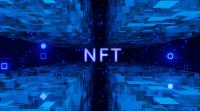NFTs Are Poised to Move Beyond Arts into Academia, Health
February 24, 2022
As NFTs work their way into the social fabric via digital art and collectibles, there is speculation that their usefulness is only beginning to be understood. While non-fungible tokens have gained popularity due to their use in illustration, music, entertainment, gaming and sports, as a medium they’re still in their infancy. As units of data saved onto a blockchain, the provenance of every NFT is trackable, substantiating ownership and authenticity. As such, there is interest in using them for everything from educational credentialing and documenting medical treatment to automotive applications and philanthropic fundraising.
“NFTs also can be used as a representation of physical assets such as gold or a watch, or documents like tickets, certificates and contracts,” reports The Wall Street Journal.

Using diplomas and certifications as examples, WSJ writes that currently they’re “issued manually and often on physical paper. The storage, verification and transmission of these credentials is largely manual, too, making them easy to fake. Presenting a paper copy of one’s diploma to prospective employers can be cumbersome, and sending an academic transcript to a prospective employer usually involves submitting a request to the issuing institution and sometimes paying a fee. To make this process easier, educational institutions could create NFTs linked to diplomas or certificates.”
Alfa Romeo plans to use NFTs to store vehicle data and generate a certificate to confirm the status of its latest Tonale model and the auto industry in general is beginning to show interest in using NFTs.
Healthcare is another area with NFT potential. “Today, patient data is scattered across multiple platforms and can be difficult to access,” WSJ points out, noting that such archiving often leads to “unnecessary or redundant treatments that stem from misdiagnosis due to poor patient-data management.”
NFTs could be used to digitally credential a patient’s health history, the information always found in one place and verifiable. Of course, such uses raise privacy issues. Typically, blockchains are public media, accessible via the Internet. But there are ways to make them private while still retaining interoperability.
Nonprofits and research organizations are another fertile area for NFTs, which could be used “to fund missions and drive social change,” WSJ reports. “NFTs may allow them to attract a new donor base, one that is young, digitally savvy, mission-driven and has deep pockets.”
In addition to privacy, environmental sustainability creates another challenge, as NFTs (and all crypto undertakings) are notorious energy hogs. Wired writes that “by the end of 2020, mining an NFT took at least 35kWh of electricity — that is, the process, from mouse click to claiming the right to produce the block, demanded that much energy, emitting 20kg of CO2.”
An alternative crypto mining technique called “proof of stake” (PoS) is being explored, along with other more environmentally friendly methods.

No Comments Yet
You can be the first to comment!
Sorry, comments for this entry are closed at this time.